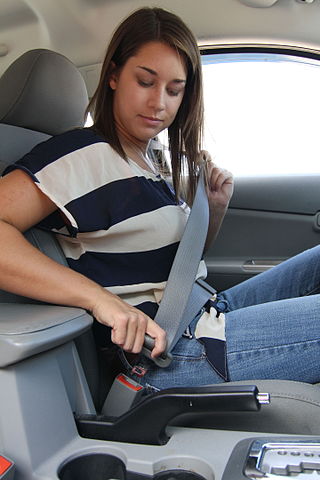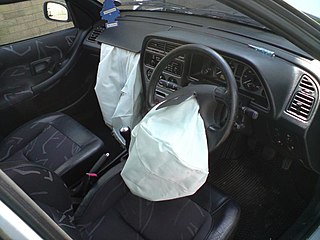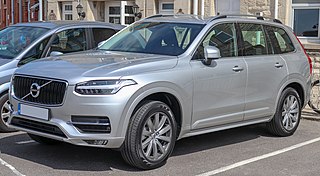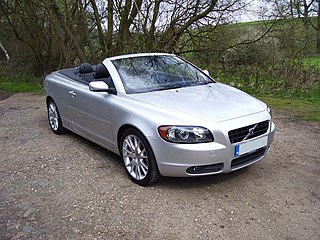
A seat belt, also known as a safety belt or spelled seatbelt, is a vehicle safety device designed to secure the driver or a passenger of a vehicle against harmful movement that may result during a collision or a sudden stop. A seat belt reduces the likelihood of death or serious injury in a traffic collision by reducing the force of secondary impacts with interior strike hazards, by keeping occupants positioned correctly for maximum effectiveness of the airbag, and by preventing occupants being ejected from the vehicle in a crash or if the vehicle rolls over.

An airbag is a vehicle occupant-restraint system using a bag designed to inflate extremely quickly, then quickly deflate during a collision. It consists of an airbag cushion, a flexible fabric bag, an inflation module, and an impact sensor. The purpose of the airbag is to provide a vehicle occupant with soft cushioning and restraint during a collision. It can reduce injuries between the flailing occupant and the interior of the vehicle.

Whiplash is a non-clinical term describing a range of injuries to the neck caused by or related to a sudden distortion of the neck associated with extension, although the exact injury mechanisms remain unknown. The term "whiplash" is a colloquialism. "Cervical acceleration–deceleration" (CAD) describes the mechanism of the injury, while the term "whiplash associated disorders" (WAD) describes the subsequent injuries and symptoms.

Automotive safety is the study and practice of automotive design, construction, equipment and regulation to minimize the occurrence and consequences of traffic collisions involving motor vehicles. Road traffic safety more broadly includes roadway design.

Volvo Cars is a Swedish multinational manufacturer of luxury vehicles. Volvo is headquartered in Torslanda, Gothenburg. The company manufactures SUVs, station wagons, and sedans. The company's main marketing arguments are safety and its Swedish heritage and design.

The Volvo S60 is a compact executive car manufactured and marketed by Volvo since 2000.

The Volvo S80 is an executive car produced by the Swedish manufacturer Volvo Cars from 1998 to 2016 across two generations. It took the place of the rear-wheel-drive S90 as Volvo's flagship sedan.

The Volvo XC60 is a compact luxury crossover SUV manufactured and marketed by Swedish automaker Volvo Cars since 2008.

The Volvo XC90 is a mid-size luxury SUV manufactured and marketed by Volvo Cars since 2002 and now in its second generation.
The Volvo P2 platform is a global full-size unibody automobile platform developed and produced by Volvo. It is designed for single wheelbases and is adaptable to front- or all wheel drive configurations. It was developed by the automaker before its 1999 acquisition by Ford Motor Company, and debuted with the 1998 Volvo S80.

The Volvo V70 is an executive car manufactured and marketed by Volvo Cars from 1996 to 2016 across three generations. The name V70 combines the letter V, standing for versatility, and 70, denoting relative platform size.

The Volvo S70 is a compact executive car produced by Volvo Cars from 1996 to 2000. The S70 was essentially a facelifted 850 saloon. The S70 was replaced with the Volvo S60.

The Volvo C70 is a two-door, four-passenger sport compact manufactured and marketed by Volvo Cars from 1996 to 2013 across two generations.

The Insurance Institute for Highway Safety and Highway Loss Data Institute (IIHS-HLDI) is an American nonprofit organization. It was established in 1959, and it is noted for its safety reviews of vehicles in various simulated traffic situations, including the effectiveness of a vehicle's structural integrity and safety systems during a collision, in addition to examining improvement on such elements.

A side collision is a vehicle crash where the side of one or more vehicles is impacted. These crashes typically occur at intersections, in parking lots, and when two vehicles pass on a multi-lane roadway.
The Aisin AW AF33 is a 5-speed automatic transaxle developed and manufactured in Anjo, Japan by Aisin AW, a division of Aisin. It is designed to be used in transverse engine configurations in both FWD and AWD configurations.

Head restraints are an automotive safety feature, attached or integrated into the top of each seat to limit the rearward movement of the adult occupant's head, relative to the torso, in a collision — to prevent or mitigate whiplash or injury to the cervical vertebrae. Since their mandatory introduction in some countries beginning in the late 1960s, head restraints have prevented or mitigated thousands of serious injuries.
Side Impact Protection System (SIPS) is a passive safety system in an automobile to protect against injury in a side collision, developed by Volvo Cars.

Saab Active Head Restraints or SAHR is a system to protect against automotive whiplash injuries introduced by Saab in 1997. It was launched when the Saab 9-5 was released for the 1998 model year and had been part of the standard equipment on the Saab 9-3 and 9-5 since.

The Volvo XC40 is a subcompact luxury crossover SUV (C-segment) manufactured by Volvo Cars. It was unveiled on 21 September 2017 as the smallest SUV model from Volvo, below the XC60. Orders started in September 2017, and manufacturing began in November 2017. It was introduced with conventional petrol and diesel engines, with a plug-in hybrid model being introduced in 2019, and a battery electric vehicle model was released in 2020 as the XC40 Recharge. A coupe version of the battery electric model with a sloping rear roof was released in 2021 as the C40 Recharge.

















